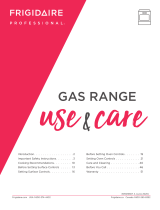
5
IMPORTANT SAFETY INSTRUCTIONS
GROUNDING INSTRUCTIONS
WARNING
Avoid re hazard or electrical shock. Failure to
follow this warning may cause serious injury,
re, or death.
Avoid re hazard or electrical shock. Do not
use an adapter plug, use an extension cord,
or remove grounding prong from the power
cord. Failure to follow this warning may cause
serious injury, re, or death.
Proper Installation—Be sure your appliance is
properly installed and grounded by a qualied
technician. In the United States, install in ac-
cordance with the National Fuel Gas Code ANSI
Z223.1/NPFA No. 54, latest edition and National
Electrical Code NFPA No. 70 latest edition, and
local electrical code requirements. In Canada,
install in accordance with CAN/CGA B149.1 and
CAN/CGA B149.2 and CSA Standard C22.1,
Canadian Electrical code, Part 1-latest editions
and local electrical code requirements. Install
only per installation instructions provided in the
literature package for this appliance.
For personal safety, this appliance must be
properly grounded. For maximum safety, the
power cord must be securely connected to an
electrical outlet or junction box that is the cor-
rect voltage, is correctly polarized and properly
grounded, and protected by a circuit breaker in
accordance with local codes.
It is the personal responsibility of the consumer
to have the appropriate outlet or junction box
with the correct, properly grounded wall recep-
tacle installed by a qualied electrician.
This appliance is equipped with a 3-prong
grounding plug for your protection against
shock hazard and should be plugged directly
into a properly grounded receptacle. Do not cut
or remove the grounding prong from this plug.
For personal safety, the appliance must be
properly grounded. For maximum safety, the
power cord must be plugged into an electrical
outlet that is correctly polarized and properly
grounded.
If a 2-prong wall receptacle is the only available
outlet, it is the personal responsibility of the
consumer to have it replaced with a properly
grounded 3-prong wall receptacle, installed by a
qualied technician.
See the installation instructions packaged with
this appliance for complete installation and
grounding instructions.
Do not cut, remove, or
bypass the grounding
plug under any
circumstances.
Grounding type
wall receptacle
Power supply cord
with 3-prong
grounding plug
Save these instruction for future reference
Conversion to (L.P.) Gas
This appliance allows for conversion to
Liquefied Petroleum (L.P.) Gas.
WARNING
Personal injury or death from electrical
shock may occur if the conversion to L.P.
gas is not made by a qualified installer
or electrician. Any additions, changes or
conversions required in order for this ap-
pliance to satisfactorily meet the applica-
tion needs must be made by a qualified
technician.
If L.P. conversion is needed, contact your
local L.P. Gas provider for assistance.





















